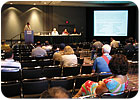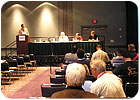
A
specialized Fabricator Forum for stoneworking professionals with five or more
years of experience was held during Coverings 2008.
Among the Fabricator Forums held this year, a session took place during Coverings 2008 that specifically targeted professionals with five or more years of experience in the trade. Panelists at the event included:
- Scott Lardner of Rocky Mountain Stone in Albuquerque, NM (moderator)
- G.K. Naquin of Stone Interiors North America, with four locations in the Southeastern U.S.
- Brandon Maldonado of Maldonado Tile & Marble in Fullerton, CA
- Brian Briggs of Turnberry Stone in Fort Pierce, FL

Panelists
at the event included (from left): Scott Lardner of Rocky Mountain Stone,
(moderator), G.K. Naquin of Stone Interiors North America, Brandon Maldonado of
Maldonado Tile & Marble in Fullerton, CA, and Brian Briggs of Turnberry
Stone in Fort Pierce, FL.
How are you removing lippage from your seams?
Briggs: The most important tool in avoiding lippage is the seam setting tool. We back bevel all seams, and we cut a biscuit groove along the sides, which we “butter” with epoxy. We get a nice tight joint.
We recently switched to epoxy for our seams. It is pre-colored and comes right out of the tube; you don’t have to mix it in a cup. Before you move on, you have to wait 15 to 20 minutes for the epoxy to set. It helps if you heat the stone.
Has anyone tried to face polish engineered stone?
Briggs: It doesn’t come up much, but we had to do it with a blue piece of DuPont Zodiaq once. It took a long time, and there was a lot of trial and error.
Maldonado:Some of the manufacturers offer education in this area.
Naquin: We haven’t had success polishing [engineered stone]. When you try and face polish, it comes out too shiny, and it’s extremely difficult to blend it in. The face of engineered stone generally comes to 40 on a gloss meter, but it comes to 80 on the gloss meter when you polish it. It really is discouraged to touch the face.
Has anyone had problems with the blade pinching or the material splitting when working with engineered stone?
Maldonado:We’ve had the material split on us, and the manufacturer replaced the slabs.
Audience Member: If you try step-cutting with engineered stone, you might reduce the chance of any problems. Also, the manufacturers say not to plunge cut. We make the small cuts first, then the larger ones and then the sink cutout.
Naquin:Any issues that we’ve had with engineered stone have been covered by the manufacturer.
Audience Member:We’ve had it happen with two different brands of engineered stone, and we’ve done stress cuts on the sides to help avoid this.
We just got into digital templating, and we are looking to purchase a plotter. Are there any recommendations?
Naquin: At our South Carolina facility, we have digital templating and a plotter, and we don’t have CNCs. It is a 60-inch vinyl plotter, but we really don’t need it. It costs around $6,000 or $7,000 and the vinyl is pretty expensive.
Briggs:You can really use any type of plotter. The key thing is to look at the software. I’ve had two different plotters. The first one came with three pages of instructions and two programs just to go from CAD to plotting. With this second one, it’s just three steps.
Is anyone using a radial arm polisher?
Briggs:We’re not using it for sinkholes, but we do some honing and antiquing where it is useful. It has also allowed us to do some book-matching of slabs.
How are you finding customers these days?
Maldonado:Most of our business comes by referral. We have only advertised in the past few years, and it never really paid off. Building relationships is key, and we make a great effort to make sure our customers are happy. We do a lot of commercial work, which has sustained us as well. We also have a vendor appreciation day every quarter, and that has helped us get referrals.
Naquin:We don’t sell retail; only wholesale. So it’s important for us to develop and build relationships. Remember, though, that promoting quality and yourself only goes so far because no one is out there saying, “I’m a terrible fabricator.” We have built a name in our region through our finished work.
In terms of ads, when you see what’s out there in terms of price and promises, you can’t compete with what people are saying. We work not to discount, but to de-bundle the pricing. Some shops offer a bare bones price at the front end, but then all of the add-ons like edgework are extra.
Briggs:We work by word of mouth and referrals. Advertising hasn’t worked well for us. We spent maybe $10,000, and it got us two jobs. When we did our first ad, we promoted our quality and service, and we were very happy with the way it turned out. And then when it ran, the ad next to it said, “Granite Counters - $9.99 per square foot.” So that really didn’t work.
We do try to make the lettering on our truck stand out, though.
Maldonado:Lettering on the truck really can be key. We have red trucks, and they get recognized in our area.
Briggs:We have scheduling software in place that tells us when to make call-backs to customers, and that has helped us greatly in getting word-of-mouth business. We even call when we lose a quote. Maybe we will call a month later, after the countertop has been installed, and ask why we lost out. A lot of times we are told that it was price, which is fine. Sometimes when we hear it was the price, they end up telling us that they were unhappy with the installed job, though.
Lardner: You must decide on which part of the market you want when it comes to price. For us, we want to educate the homeowner on the perceived value of granite, and that has worked well with our kitchen and bath remodels. We market quality and service, and not price. In our area, the smaller shops with low costs are closing down.
Briggs:The low-cost shops in our area are hurting as well. So are the high-volume production shops now that the volume isn’t there.
Maldonado:We only became businessmen 10 years ago. A lot of stone fabricators are craftsmen with an entrepreneurial spirit. But I make sure that I know what our break-even goal is in terms of sales every month.
How much are people investing in equipment these days?
Briggs:We had almost bought a CNC, but we saw the market decline in our area. You have to know that the steady workflow will be there before you make that type of investment. But it’s not just volume. It might make sense doing only four or five kitchens per week if the type of work is right. But for straight runs, maybe you’re better off buying a line polishing machine.
Maldonado:You have to do your research. We spent money on a CNC, and we really didn’t do the type of work that warranted it at the time, so we took a loss at first. Now, the CNC is very profitable for us because of the type of work we are doing. We do very few standard edges.
Naquin: There is a lot of technology out there. Compared to the “old” CNCs, you now have robots, bridge saw/waterjets, workstations, etc.
But no matter what the technology, if you listen only to what the machine can do and don’t directly address your market, you can easily make the wrong choices. It’s the same with digital templating. Sometimes people look at the features, but not what the templater wants.
Maldonado:Also, we’re used to hiring craftsmen in our shop, but you don’t hire a craftsman to run a CNC machine.
What are some of the methods people are using for securing undermount sinks?
Maldonado: Using sink setters - metal brackets - has solved me a lot of problems.
Naquin:We will build a cradle or a “T,” depending on the cabinet structure. We transfer the eight to the cabinet structure and wall. Also, we make sure that the cabinets are screwed into the wall. If this isn’t done, the measurements won’t be right.
Briggs:We use T-31 anchors and silicone - not just at the four corners. If we’re installing a cast iron or pottery sink, we will build a cradle.
Is anyone getting a full edge polish using their CNC machine?
Naquin:Very few pieces ever reach a full polish, but the guys doing our water polishers aren’t highly paid employees. By “polish,” I mean touching up the edges. This is work that can be done by beginners, and an experienced fabricator isn’t necessary.
Audience Member:To get a full polish on the CNC takes about one-third more time. It’s better to do more volume and take the edge to the metal [bits], but not the polishing [bits]. That has also allowed us to store more edge profiles on the machine.